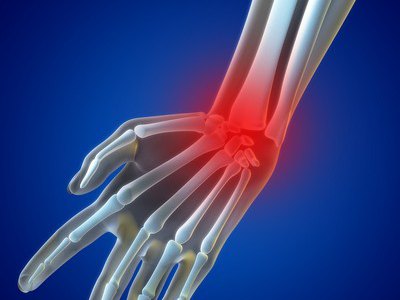The Triangular Fibrocartilage Complex (TFCC) is a complex structure within the wrist joint, acting as a major stabilizer of the joints between the forearm and the hand. The TFCC carries approximately 20% of load transmitted from the wrist to the forearm, as well as allowing for complex movements of the wrist. The TFCC is made up of six different components, including an articular disc (similar to the cartilage found in the knee joint), ligaments, and tendons.
TFCC injury can occur as a result of a traumatic injury e.g. falling on an outstretched hand, or it may be as a result of a degenerative (wear and tear) process. Risk factors for developing this particular injury include:
- Increasing age. Research has shown that the TFCC begins to degenerate from as early as the second and third decade of life.
- Previous history of wrist fracture/s
- Gout
- Rheumatoid Arthritis
- Chronic overloading of the wrist joint
- Anatomical abnormalities i.e. where the length of the ulna is comparatively longer than the radius (bones of the forearm)
Symptoms of TFCC injury include:
- Pain on the outer aspect of the wrist +/- clicking sensation
- Swelling over the outer aspect of the wrist joint
- Reduced grip strength, or difficulty bearing weight through that hand
- Pain that is worse with twisting, or rotational movements e.g. opening a door handle, using a screwdriver, or lifting heavy objects
TFCC injury is a common injury seen in many sports such as gymnastics, boxing, hockey, golf and tennis.
If you suspect you may have a TFCC injury, it is important to see a qualified doctor or physiotherapist who will be able to accurately diagnose your injury. Wrist injuries are often complex and their management will vary greatly; as such it is vital that the correct diagnosis is made. Your practitioner will also be able to refer you for imaging, if this is indicated.
Most TFCC injuries respond well to conservative treatment including:
- A short period (4-6 weeks) of immobilization in a splint or cast
- Rest from aggravating activity
- Regular Icing
- Anti-inflammatories
- +/- Cortisone injection
- Biomechanical/Equipment analysis, particularly if you play any sports
- Physiotherapy
- Taping specific for TFCC injury- speak to your physiotherapist
If conservative treatment is unsuccessful (> 3 months), or if there is any associated instability within the wrist that may be caused by a displaced fracture, surgery may be indicated.
– Diana Mladenoski

